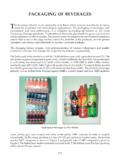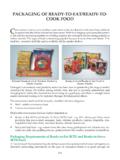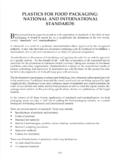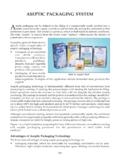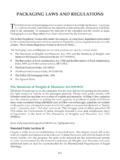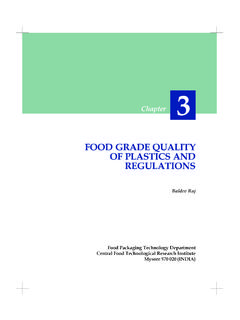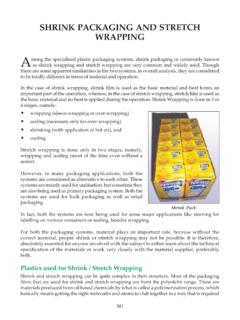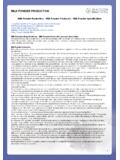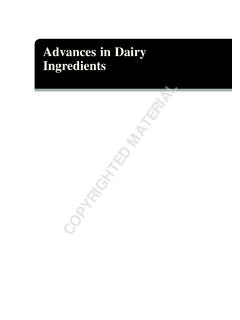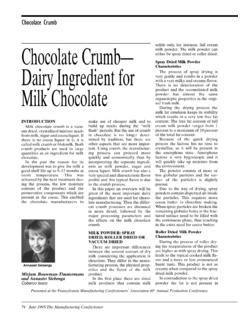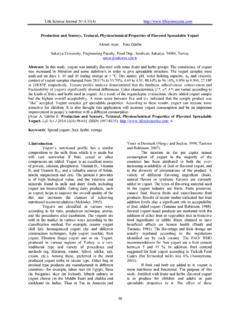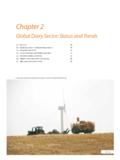Transcription of PACKAGING ASPECTS OF MILK & MILK BASED PRODUCTS - …
1 191 PLASTICS IN FOOD PACKAGINGPACKAGING ASPECTS OF milk & milk BASED PRODUCTSC hapter11 PACKAGING ASPECTS OF milk & milk BASED PRODUCTSK R KumarFood PACKAGING Technology DepartmentCentral Food Technological Research InstituteMysore 570 020 (INDIA)192 PLASTICS IN FOOD PACKAGINGC hapter 11193 PLASTICS IN FOOD PACKAGINGPACKAGING ASPECTS OF milk & milk BASED PRODUCTSC hapter 11 PACKAGING ASPECTS OF milk & milk BASED PRODUCTSINTRODUCTIONT raditional milk - BASED PRODUCTS haveplayed a significant role in the cultural andnutritional areas of our country.
2 Moreoften, these PRODUCTS are produced inunorganized small-scale sector. Althoughstandardization in quality and mechani-zation in production are taking place, thereis a great need for the development ofappropriate and economical is the vital link in the entirechain of production, storage, transporta-tion, distribution and marketing. Functionalpackaging of dairy PRODUCTS leads not onlyto resource raising and their optimalutilization, but also protects the contentsagainst deteriorative changes andassociated MILKL iquid milk forms a major item of foodin our country especially in rural areas.
3 Itforms the major ingredient in beverages,tea and coffee and essential part of the dieteither as milk itself or as curd, butter milk ,ghee and milk is marketed by door-to-doorvending and the containers used are oftenunhygienic. Also, loose-vending introducesthe possibility of mixing with water andalso harmful ingredients. Hence, properpackaging assumes greater importance inthe distribution of raw and pasteurized milkin hygienic and wholesome form in specifiedvolumes leading to consumer convenienceand , being a complex physico-chemicalsystem, consists of a water solution of salts,lactose, lactalbumin, etc.
4 Proteins are dis-persed in a colloidal form while milk -fatsolids are present in a partially is susceptible to oxidation of fat(phospholipids in milk ) which produces awaxy odour. This dete-riorative change isenhanced by heat, acid and metallic of milk to natural and artificial(fluorescent) light leads to deterioration inquality and loss of , a package intended for milkshould possess the following protectivefunctions:i)Protection against contamination due todirt and )Protection against light and IN FOOD PACKAGINGC hapter 11iii)Protection against external )Physical protection to withstanddistribution Distribution of MilkThe conventional containers for bulkpackaging and distribution are thealuminium cans with lids, while in recentyears, bulk vending by machines throughoperation by token system has becomepopular.
5 This system is now operatingsuccessfully in many cities. Bulk vendingis well suited to Indian consumers since itallows the purchase of relatively smallquantities of milk , two times a day and useof buyers own containers avoiding the costand inconvenience of handling bottles orpouches. The system ensures hygienic,good quality milk at a price reflecting lowoverheads and low PACKAGING is claimed that the capital cost of bulkvending system is nearly 20% less than thebottling system and the operating andrunning cost less than 50%.
6 The milk lossesare claimed to be between and in BottlesThis was the most universally acceptedmilk distribution system before the adventof single-serve containers. The bottlingsystem is highly capital intensive notonly the bottle filling and washing machi-nes are costly, but the system requires largeroperational areas, large store space, and fullyautomatic machines are difficult andexpensive to maintain while the manualsystems require a large labour costs for distribution are highsince the weight of empty bottles and cratesis nearly the same as that of the quantity ofmilk distributed.
7 The collection, washingand accounting of return bottles is costlyand the context of existing bad roads inmost of the cities and unsystematic handlingoperations, the bottle breakage is very leads not only to higher milk losses,but also to added cost of handling. Themilk losses vary between and in Non-ReturnableContainersPlastic pouches: Most of the dairies incities of India have introduced packagingand distribution of milk throughpolyethylene pouches. The plastic pouchesare single-trip packages, very light inweight, and hence distribution costs are lesscompared to glass bottles.
8 Losses duringpouch filling are less than bottle filling andless floor space is required for packingsection and cold of Indian Standards prescribesrequirements and testing of polyethylenepouches for the packing of pasteurizedliquid milk in 1 litre and litre capacities inIS:11805-1986. According to this standard,the pouches should be made from virginpolyethylene (LDPE, LLDPE, HDPE or EVA)for meeting the food grade , LDPE film was used for milkpackaging but now LLDPE is the preferredchoice.
9 More recently, octene and butene- BASED LLDPE are used due to the followingfactors:i)Reduction in losses due to losses due to leakage vary from195 PLASTICS IN FOOD PACKAGINGPACKAGING ASPECTS OF milk & milk BASED PRODUCTS1-5% with LDPE film and withLLDPE )Reduction in the area of pouches tosuitable limits by reducing the length ofpouches. This leads to saving of 3pouches/kg and 1 pouch/kg for litre pouches )Enhancement in yield (number ofpouches per kg) by down-gauging.
10 Ithas been shown that by reducing thethickness of film by one micron only, 1kg of film will give 9 half-litre pouchesand 6 one-litre pouches has been shown that coloured cartons(Purepack) and pigmented pouch (black)with light transmission of less than 1% inthe visible spectrum were very effective inpreventing light induced changes in milk (350-750 nm) whereas polyethylene jugswith 2% titanium dioxide were not revised BIS Standard (2003) forpolyethylene pouches for PACKAGING liquidmilk - specifications (2nd revision) indicatesthat the material shall be made from virginpolyethylene (LDPE, LLDPE or a blendthereof) trim meeting the food graderequirements.

